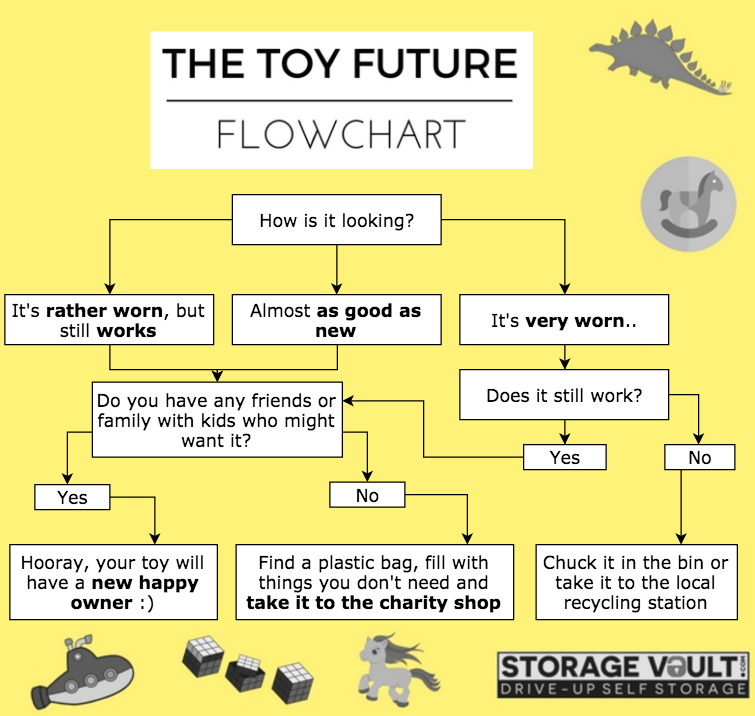“No, don’t give it away! That toy is my favourite!” your child screams to the fourth toy in a row.
Mountains of toys pile up around you. Everywhere you look there’s a tribe of Playmobil characters ganging up on you or a cascade of cheap pound-shop bouncy balls gearing up to trip you over.
Something needs to be done!
This toy decluttering guide streamlines the toy purging process, pacifying angry outbursts from your children.

Contents
Preventative Measures
The easiest way to stop toys building up is to stop buying so many in the first place!
Your children might have pocket money to buy a few nick-nacks here and there, but they’ve not amassed this collection alone.
Think about your motivation for purchasing toys for your children.
Is it out of guilt? Is it cheap? Is it educational?
Remind yourself that your child will still love you without lavish gifts. In the long run, it’ll probably even benefit your child to have fewer toys, encouraging them to be more creative, resourceful, and grateful for what they do have.
Setting a toy budget is also a great preventative measure. Like other amenities, you put a cap on how much you’ll spend, so why should toys be any different?
Make It Fun!
When it comes to the dreaded purge, make the process lighthearted!
Involve your child. They’ll build trust in you this way, knowing that they have an element of control.
Play music and make sure you have plenty of juice and snacks to energise you!
Categorise
Rome wasn’t built in a day, so there’s no reason why the full declutter should either.
To prevent you from feeling overwhelmed, carry it out in categories.
Start with the bath toys for example, before moving on to books, or stuffed animals.
Gather everything your child owns in a category, laying it out on the floor. It might shock them to see how many Barbies they have!
This helps your child to see exactly what they have, making the act of letting go a bit easier.
The 3 Box Experiment
Get 3 boxes: one for the things they play with all the time; one for toys they use sometimes; and one for toys they never use.
Ask your child a few key questions for each toy:
- Do you love it?
- Do you use it?
- Do we have room for it?
Ask yourself whether the toy is in good condition or if it’s age-appropriate. Place each toy in the appropriate box.
Take the ‘never used’ toys to charity, recycle them, or donate them to a friend’s children.
Place the ‘sometimes used’ toys in a hidden place. If they ask for a toy out of it, keep it in circulation.
It’s also an idea to keep an eye on the toys they’re playing with. Move neglected toys to the hidden place and bring things back if the little ones are asking for it.
After a while, your child will probably forget about the hidden toys. Donate them too.

Sentimental Items
You may find there are toys that you don’t want to part with.
Maybe it’s a tatty teddy bear in no condition to donate, but it’s from the day they were born.
Or perhaps it’s their first Duplo set. They build full-scale Lego models now, but you want a reminder of their first creations.
There’s no need to throw these out if they mean a lot.
Store important toys in your attic, basement, or in a self-storage unit. They’ll be safe and easily reachable whenever you want to reminisce.
Storage Solutions
Establish storage rules to prevent clutter.
Designate a toy storage area, be it their bedroom, playroom, or living room corner.
You might want boxes with labels for each toy category. You could use over-the-door shoe organisers to slot in dolls and action figures. Under-bed storage is fantastic for Lego pieces.
Your child will learn they need to be responsible and tidy up after themselves!
And Repeat!
Don’t let your work go to waste. Purge often!
Purge before Christmas and birthdays. This way you won’t experience panicked visions of overflowing toy chests as they unwrap yet another teddy.
Keep on top of it and the decluttering process will be manageable!

About the Author
Carol is a freelance writer for Storage Vault Cambuslang and is absolutely bonkers about storage and productivity. If not writing lists, press releases or blog articles — you can find her exploring the Scottish highlands with her Macbook and notepad looking for inspiration and adventure.





Leave a Reply